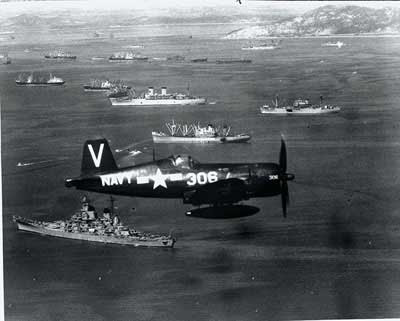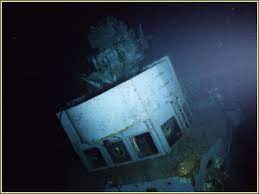Battle of Midway A/H
The following information



Battle of Midway: June 4th-7th, 1942
The United States was hurt a lot at Pearl Harbor.

Pearl Harbor Damage
Soon after that attack the Japanese also attacked us at The Philippines on December 8th, 1941, the day after Pearl Harbor. They finally defeated us there on the 8th of May, 1942.
The Japanese landed all over (see red arrows), and soon had pushed us to just that little place in red, the Bataan Peninsula.
Things were not looking good for the United States in the war in The Pacific.
Between May 4th and 8th we and the Australians fought a battle at sea against the Japanese Navy. It was in an area of the Pacific called The Coral Sea.
The place where this fight happened is near Australia
The Japanese destroyed more of our ships and airplanes than we destroyed of theirs. However, we stopped the Japanese plan to invade Australia. It was kind of a draw (nobody won).
The place where this fight happened is near Australia
The Japanese destroyed more of our ships and airplanes than we destroyed of theirs. However, we stopped the Japanese plan to invade Australia. It was kind of a draw (nobody won).
This set the stage for what would happen two months later near a little island in the middle of the pacific controlled by The United States called Midway Island.
See Midway Island to the North and West of Hawaii
What Happened:
Japanese commander Admiral Isoroku Yamamoto moved toward Midway to try to get the U.S. ships to follow and attack him. He thought he was so much more powerful that he could destroy the U.S. Navy's aircraft carriers.
U.S.S. Enterprise aircraft carrier. See the planes on her deck?
Yamamoto's surprise was ruined by American communications information (intelligence), which figured out his plan well before the battle started. This allowed Admiral Chester W. Nimitz, the U.S. Pacific Fleet commander, to set an ambush (where you sneak up on someone and attack them). On 4 June 1942, the fight started.
At 0430 (4:30 AM) in the morning of 4 June 1942, still 240 miles away from Midway Island, Japan launched 108 attack planes from their four aircraft carriers to attack the U.S. base at Midway Island.
What the Japanese did not know was that there were three U.S. aircraft carriers only 215 miles from the Japanese ships. The two opposing fleets (groups of navy ships) sent out search planes to try to find each other. Seaplanes (planes that could land on water) from Midway were also patrolling along the expected Japanese attack path. One of these spotted, and reported, the Japanese ships at about 0530 (5:30 am).
What the Japanese did not know was that there were three U.S. aircraft carriers only 215 miles from the Japanese ships. The two opposing fleets (groups of navy ships) sent out search planes to try to find each other. Seaplanes (planes that could land on water) from Midway were also patrolling along the expected Japanese attack path. One of these spotted, and reported, the Japanese ships at about 0530 (5:30 am).
Ships and a plane of the U.S. Pacific Fleet
Remember, the Japanese, not knowing the U.S. Aircraft carriers were so near, were attacking the Midway Island. They did some damage to buildings on the island. Midway had U.S. airplanes, which attacked the Japanese ships, and were mostly shot out of the air and crashed.
The leaders of the U.S. navy ships decided they had to attack right away before the Japanese found them. They could not send all of their planes, but they sent the ones that were ready to go. They were torpedo planes (planes that can launch a torpedo from their belly. [The picture in the link show how they are about to fold down the wings on this plan so it can take off and attack the Japanese.])
Soon our torpedo planes (This picture is from about 7:30 am, 4 June 1942, the morning of the attack) attacked the Japanese ships. EVERY ONE of them was destroyed. Not a single U.S. torpedo hit a Japanese ship. All 15 U.S planes in the attack were shot down by Japanese fighter planes, killing all pilots.
U.S. torpedo bomber. They dropped their torpedo into the water so it would go under water and hit an enemy ship
Those men’s lives were not wasted, because the Japanese planes protecting their ships were now out of gas and bullets, so they had to land to get more. The Japanese planes that had attacked the island were also getting more fuel, bombs, and bullets.
Then, when the Japanese heard that our aircraft carriers (ships that have planes on them) were near they started putting torpedoes on their planes to attack the ships, instead of more bombs to attack the island again. What this all means is that the Japanese were taking a LOT of time, and had all kinds of gas, bullets, bombs, and torpedoes sitting around on the deck their ships. The deck is the flat top where planes land and take off.
U.S. dive bomber aiming for Japanese ships
Why was that such a big deal? Well, what do YOU think would happened when bombs start hitting a place where there is a lot of gas, bullets, bombs, and torpedoes sitting around? Right, large BOOMS!!!
Movie scene of U.S. dive bombers hitting Japanese aircraft carriers
Mitsuo Fuchida, the Japanese pilot who led the attack on Pearl Harbor, was on the Akagi when it was hit, and described the attack:
“A look-out screamed: "Hell-Divers!" I looked up to see three black enemy planes plummeting towards our ship. Some of our machine guns managed to fire a few frantic bursts at them, but it was too late. The plump silhouettes of the American Dauntless dive-bombers quickly grew larger, and then a number of black objects suddenly floated eerily from their wings.”
| |
When the fighting was finally over on June 6th, 1942 we (The U.S.) had sunk 4 of the most important Japanese aircraft carriers.
Japanese carrier Hiryu burning before sinking
One of the U.S. aircraft carriers, the USS Yorktown, was so badly damaged that she sank. Look here for a picture of what she looks like on the bottom of the ocean 16,650 feet down. That is over 3 miles.
Control tower and guns of USS Yorktown on bottom of Ocean today. Right now.
Why was The Battle of Midway such a BIG Turning Point???
Prior to this fight, Japan had a HUGE navy advantage over the United States and could usually pick where and when to attack. After Midway, the we were pretty much equal in power with the Japanese. This allowed US to soon start attacking the Japanese instead of sitting around waiting for them to hit us. Eventually we were stronger than the Japanese.



Comments
Post a Comment